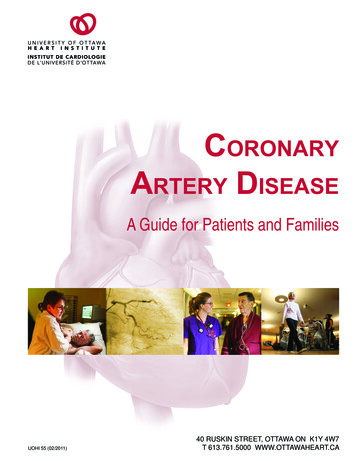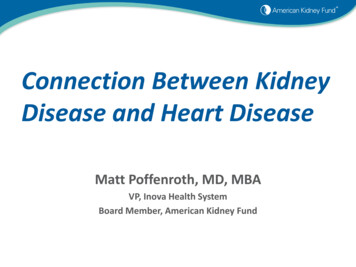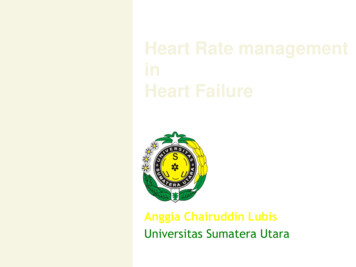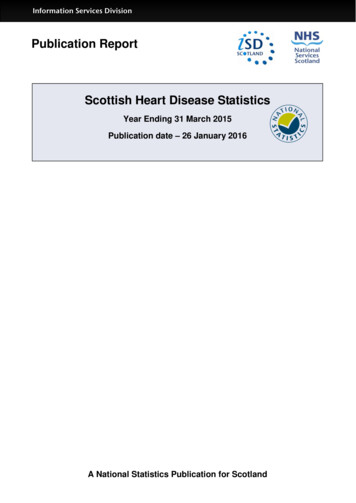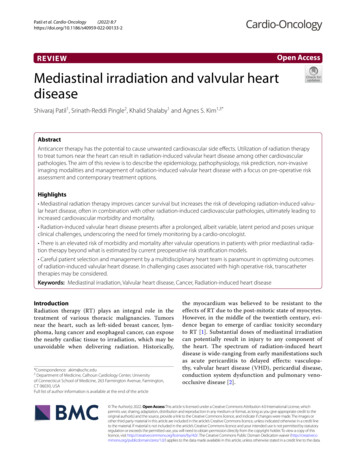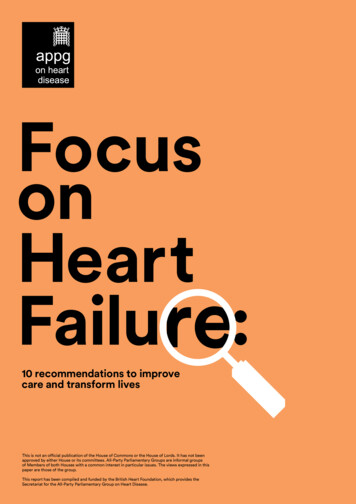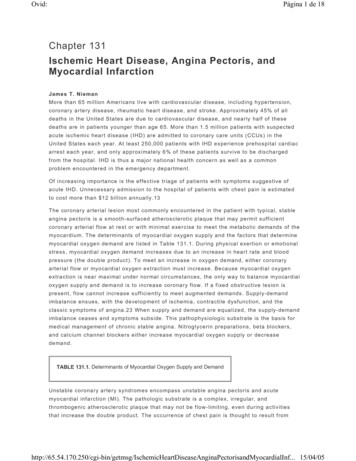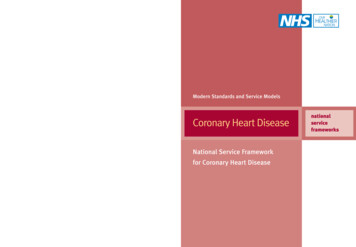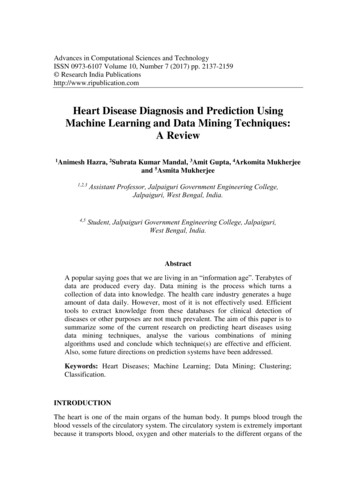
Transcription
Advances in Computational Sciences and TechnologyISSN 0973-6107 Volume 10, Number 7 (2017) pp. 2137-2159 Research India Publicationshttp://www.ripublication.comHeart Disease Diagnosis and Prediction UsingMachine Learning and Data Mining Techniques:A Review1AnimeshHazra, 2Subrata Kumar Mandal, 3Amit Gupta, 4Arkomita Mukherjeeand 5Asmita Mukherjee1,2,34,5Assistant Professor, Jalpaiguri Government Engineering College,Jalpaiguri, West Bengal, India.Student, Jalpaiguri Government Engineering College, Jalpaiguri,West Bengal, India.AbstractA popular saying goes that we are living in an “information age”. Terabytes ofdata are produced every day. Data mining is the process which turns acollection of data into knowledge. The health care industry generates a hugeamount of data daily. However, most of it is not effectively used. Efficienttools to extract knowledge from these databases for clinical detection ofdiseases or other purposes are not much prevalent. The aim of this paper is tosummarize some of the current research on predicting heart diseases usingdata mining techniques, analyse the various combinations of miningalgorithms used and conclude which technique(s) are effective and efficient.Also, some future directions on prediction systems have been addressed.Keywords: Heart Diseases; Machine Learning; Data Mining; Clustering;Classification.INTRODUCTIONThe heart is one of the main organs of the human body. It pumps blood trough theblood vessels of the circulatory system. The circulatory system is extremely importantbecause it transports blood, oxygen and other materials to the different organs of the
2138Animesh Hazra et albody. Heart plays the most crucial role in circulatory system. If the heart does notfunction properly then it will lead to serious health conditions including death.1 . Types of Cardiovascular DiseasesHeart diseases or cardiovascular diseases (CVD) are a class of diseases that involvethe heart and blood vessels. Cardiovascular disease includes coronary artery diseases(CAD) like angina and myocardial infarction (commonly known as a heartattack).There is another heart disease, called coronary heart disease(CHD), in whicha waxy substance called plaque develops inside the coronary arteries. These are thearteries which supply oxygen-rich blood to heart muscle. When plaque begins to buildup in these arteries, the condition is called atherosclerosis. The development of plaqueoccurs over many years. With the passage of time, this plaque can harden or rupture(break open). Hardened plaque eventually narrows the coronary arteries which in turnreduces the flow of oxygen-rich blood to the heart. If this plaque ruptures, a blood clotcan form on its surface. A large blood clot can most of the time completely blockblood flow through a coronary artery. Over time, the ruptured plaque also hardens andnarrows the coronary arteries. If the stopped blood flow isn’t restored quickly, thesection of heart muscle begins to die. Without quick treatment, a heart attack can leadto serious health problems and even death. Heart attack is a common cause of deathworldwide. Some of the common symptoms of heart attack [2] are as follows.1.1. Chest painIt is the most common symptom of heart attack. If someone has a blocked artery or ishaving a heart attack, he may feel pain, tightness or pressure in the chest.1.2. Nausea,Indigestion, Heartburn and Stomach PainThese are some of the often overlooked symptoms of heart attack. Women tend toshow these symptoms more than men.1.3. Pain in the ArmsThe pain often starts in the chest and then moves towards the arms, especially in theleft side.1.4. Feeling Dizzy and Light HeadedThings that lead to the loss of balance.1.5. FatigueSimple chores which begin to set a feeling of tiredness should not be ignored.1.6. SweatingSome other cardiovascular diseases which are quite common are stroke, heartfailure, hypertensive heart disease, rheumatic heart disease, Cardiomyopathy,Cardiacarrhythmia, Congenital heart disease, Valvular heart disease, Aorticaneurysms, Peripheral artery disease and Venous thrombosis. Heart diseases may
Heart Disease Diagnosis and Prediction Using Machine Learning and Data 2139develop due to certain abnormalities in the functioning of the circulatory system ormay be aggravated by certain lifestyle choices like smoking, certain eating habits,sedentary life and others. If the heart diseases are detected earlier then it can betreated properly and kept under control. Here, early detection is the main key. Beingwell informed about the whys and wherefores of heart disease will help in preventionsummarily.Prevalence of Cardiovascular DiseasesAn estimated 17.5 million deaths occur due to cardiovascular diseases worldwide.More than 75% deaths due to cardiovascular diseases occur in the middle-income andlow-income countries. Also, 80% of the deaths that occur due to CVDs are because ofstroke and heart attack [3]. India too has a growing number of CVD patients addedevery year. Currently, the number of heart disease patients in India is more than 30million. Over two lakh open heart surgeries are performed in India each year. Amatter of growing concern is that the number of patients requiring coronaryinterventions has been rising at 20% to 30% for the past few years [4].The rest of the paper is organized as follows. Section 2 describes some of the wellknown data mining algorithms used for heart disease prediction. Section 3 describessome of the popular data mining tools used for the data analysis purpose. Section 4summarizes the methodologies and results of previous research on heart diseasediagnosis and prediction. Section 5 discusses the pros and cons on literature survey.Finally, Section 6 concludes the paper along with future scope.DATA MINING ALGORITHMSResearch on data mining has led to the formulation of several data mining algorithms.These algorithms can be directly used on a dataset for creating some models or todraw vital conclusions and inferences from that dataset. Some popular data miningalgorithms are Decision tree, Naïve Bayes, k-means, artificial neural network etc.They are discussed in the follows section.1. Decision TreeA Decision tree is a decision support tool that uses a tree-like graph or model ofdecisions and their possible consequences including chance event outcomesand utility. It is one of the ways to display an algorithm. Decision trees are commonlyused in operations research, specifically in decision analysis to help and identify astrategy that will most likely reach the goal. It is also a popular tool in machinelearning. A Decision tree can easily be transformed to a set of rules by mapping fromthe root node to the leaf nodes one by one. Finally by following these rules,appropriate conclusions can be reached
2140Animesh Hazra et al2. C4.5It is a classifier in the form of a Decision tree. It is a supervised learning methodwhich uses information gain and pruning for improved results. It is quite fast, popularand the output is easily interpretable.3. K-means AlgorithmK-means creates k groups from a set of given objects so that the members of a groupare more similar. Other than specifying the number of clusters, k-means also “learns”the clusters on its own without any information about which cluster a particularobservation should belong to. That’s why k-means can be called as semi-supervisedlearning method. K-means is specially effective over large datasets.4. ID3 AlgorithmThe ID3 algorithm (Quinlan86) is a Decision tree building algorithm whichdetermines the classification of objects by testing the values of the properties. It buildsthe tree in a top down fashion, starting from a set of objects and the specification ofproperties. At each node of the tree, a property is tested and the results used topartition the object at that point are set. This process is recursively continued till theset in a given sub tree is homogeneous with respect to the classification criteria. Thenit becomes a leaf node. At each node, information gain is maximized and entropy isminimized. In simpler words, that property is tested which divides the candidate set inthe most homogeneous subsets.5. Support Vector Machine(SVM)It is a supervised learning method which classifies data into two classes over a hyperplane. Support vector machine performs a similar task like C4.5 except that it doesn’tuse Decision trees at all. Support vector machine attempts to maximize the margin(distance between the hyper plane and the two closest data points from eachrespective class) to decrease any chance of misclassification. Somepopular implementations of support vector machine are scikit-learn, MATLAB and ofLIBSVM.6. Naive Bayes(NB)It is a simple technique for constructing classifiers. It is a probabilistic classifier basedon Bayes' theorem. All Naive Bayes classifiers assume that the value of any particularfeature is independent of the value of any other feature, given the class variable.Bayes theorem is given as follows: P(C X) P(X C) * P(C)/P(X), where X is the datatuple and C is the class such that P(X) is constant for all classes. Though it assumes anunrealistic condition that attribute values are conditionally independent, it performssurprisingly well on large datasets where this condition is assumed and holds.
Heart Disease Diagnosis and Prediction Using Machine Learning and Data 21417. Artificial Neural Network (ANN)An artificial neural network (ANN) is a computational model based on the structureand functions of biological neural networks. Information which flows through thenetwork affects the structure of the artificial neural network because a neural networkchanges or learns in a sense-based on input and output, for that particular stage andconsequently for each stage. ANN’s are considered nonlinear statistical datamodelling tools where the complex relationships between inputs and outputs aremodelled or patterns are found .ANNs have layers that are interconnected. Artificialneural networks are fairly simple mathematical models to enhance existing dataanalysis technologies.8. CARTCART stands for Classification and Regression Trees methodology. In classificationtrees the target variable is categorical and the tree is used to identify the "class" withinwhich a target variable would likely fall into.In regression trees, the target variable iscontinuous and a tree is used to predict its value. The CART algorithm is structured asa sequence of questions, the answers to which determine what will be the nextquestion if there should be any questions. The result of these questions look like atree structure where the ends are terminal nodes which represent that there are nomore queries.9. Random ForestRandom Forests are an ensemble learning method (also thought of as a form ofnearest neighbor predictor) for classification and regression techniques. It constructsa number of Decision trees at training time and outputs the class that is the mode ofthe classes output by individual trees. It also tries to minimize the problems of highvariance and high bias by averaging to find a natural balance between the twoextremes. Both R and Python have robust packages to implement this algorithm.10. RegressionRegression is a statistical concept which is used to determine the weight ofrelationship between one dependent variable (usually denoted by Y) and a series ofother changing variables (known as independent variables). Two basic types ofregression are linear regression and multiple linear regression. Also, there are severalnon-linear regression methods that are used for more complicated data analysis.11. J48J48 is a Decision tree that is an implementation of ID3 (Iterative Dichtomiser 3)developed by the WEKA project team. R language also has a package to implementthis. J48 does not require discretization of numeric attributes.
2142Animesh Hazra et al12. A-Priori AlgorithmsIt is an algorithm for frequent item set mining and association rule learning. A-prioriuses breadth-first search algorithm and a hash structure to count candidate item setsefficiently. It generates candidate item sets of length k from item sets of length k1 .Then it prunes the candidates which have an infrequent sub pattern.13. Fuzzy LogicIt is a form of many-valued logic in which the truth values of variables may be anyreal number between 0 and 1. Fuzzy logic is applicable in many fields from controltheory to artificial intelligence. Fuzzy logic is mainly employed to handle the conceptof partial truth where the truth value may range between completely true andcompletely false. Among various combinations of methodologies in soft computing,fuzzy logic and neuro computing are very practical and popular techniques leading todevelopment of neuro-fuzzy systems.14. Association RulesAssociation rules are basically if/then statements which help us to find out therelationships between apparently unrelated data in an information warehouse. It hastwo parts, an antecedent (if) and a consequent (then).Association rules are created byanalyzing a data set for frequentif/then patterns. Using thecriteria support and confidence, itidentifiesthemostimportantrelationships. Support indicates that how frequently the items appear in the databasewhile confidence shows the number of times the if/then statements have been found tobe true. In data mining, association rules are very useful for analyzing and predictingcustomer behaviour. Programmers use association rules to build programs capableof machine learning.DATA MINING TOOLSData mining tools provide ready to use implementation of the mining algorithms.Most of them are free open source software’s so that researchers can easily use them.They have an easy to use interface. Some of the popular data mining tools are WEKA,RapidMiner, TANAGRA, MATLAB etc. Some of them are discussed as follows.1. WEKAIt stands for Waikato Environment for Knowledge Learning. It is a computer programthat was developed at the University of Waikato in New Zealand for the purpose ofidentifying information from raw data. WEKA supports different standard datamining tasks such as data pre-processing, classification, clustering, regression,visualization and feature selection. The basic premise of this application is to utilize a
Heart Disease Diagnosis and Prediction Using Machine Learning and Data 2143computer application that can be trained to perform machine learning capabilities andderive useful information in the form of trends and patterns. Originally written in C,the WEKA application was then completely rewritten in Java and is now compatiblewith almost every computing platform. Its user friendly graphical interface allows forquick set up and operation.2. RapidMinerFormerly called as YALE (Yet Another Learning Environment), is an environmentfor providing data mining and machine learning procedures including data loadingand transformation (ETL), data preprocessing and visualization, modeling, evaluationand deployment. Rapid Miner is written in the Java programming language. Also, itcan be used for text mining, multimedia mining, feature engineering, data streammining etc.3. TANAGRAIt is a free data mining software designed for academic and research purposes. Itproposes several data mining methods such as exploratory data analysis, statisticallearning and machine learning. TANAGRA comprises some paradigms andalgorithms such as clustering, association rule, parametric and nonparametricstatistics, factorial analysis, feature selection and construction algorithms.4. Apache MahoutIt is a project of the Apache Software Foundation designed for free implementationsof distributed or otherwise scalable machine learning algorithms that focus primarilyin the areas of collaborative filtering, clustering and classification. Apache Hadoop isanother open source, Java-based programming framework which supports theprocessing and storage of extremely large data sets in a distributed computingenvironment. It is a part of the Apache project which is sponsored by the ApacheSoftware Foundation.5. MATLABIt is the short form for matrix laboratory. It supports a multi-paradigm numericalcomputing environment. It is a fourth-generation programming language. MATLABprovidesmatrix manipulations, plotting of functions and data, algorithmimplementations, creation of user interfaces and interfacing with programs written inother languages including C, C ,C#, Java, Fortran and Python [41].
2144Animesh Hazra et al6. JavaJava is a high level programming language developed by Sun Microsystems and nowowned by Oracle Inc. It is widely used for developing and delivering content on theweb. Java has numerous object oriented programming features much like C , but issimplified to eliminate language features that cause common programming errors.Java language is well suited for use on the World Wide Web. Java applets (small Javaapplications) can be downloaded from a web server and run on a computer by a Javacompatible web browser.7. CC was developed by Dennis M. Ritchie at Bell Labs for the Unix Operating System inthe early 1970s.It was originally intended for writing system softwares. C is a highlevel, general-purpose programming language which is ideal for developing firmwareand portable applications.8. OrangeIt is a toolkit for data visualisation, machine learning and data mining. It is interactiveand can be used as a Python library.LITERATURE SURVEYThere are thirty five research papers that explore the computational methods to predictheart diseases. The summaries of them have been presented in a nutshell.Shaikh Abdul Hannan et al. [5] used a Radial Basis Function(RBF) to predict themedical prescription for heart disease. About 300 patient’s data were collected fromthe Sahara Hospital, Aurangabad. RBFNN (Radial Basis Function–Neural Network)can be described as a three-layer feed forward structure. The three layers are the inputlayer, hidden layer and output layer. The hidden layer consists of a number of RBFunits (nh) and bias (bk). Each neuron on the hidden layer uses a radial basis function asa nonlinear transfer function to operate on the input data. The most often used RBF isusually a Gaussian function. Designing a RBFNN involves selecting centres, numberof hidden layer units, width and weights. The various ways of selecting the centres arerandom subset selection, k-means clustering and others. The methodology wasapplied in MATLAB. Obtained results show that radial basis function can besuccessfully used (with an accuracy of 90 to 97%) for prescribing the medicines forheart disease.AH Chen et al. [6] presented a heart disease prediction system that can aid doctors inpredicting heart disease status based on the clinical data of patients. Thirteenimportant clinical features such as age, sex, chest pain type were selected. Anartificial neural network algorithm was used for classifying heart disease based on
Heart Disease Diagnosis and Prediction Using Machine Learning and Data 2145these clinical features. Data was collected from machine learning repository of UCI.The artificial neural network model contained three layers i.e. the input layer, thehidden layer and the output layer having 13 neurons, 6 neurons and 2 neuronsrespectively. Learning Vector Quantization (LVQ) was used in this study. LVQ is aspecial case of an artificial neural network that applies a prototype-based supervisedclassification algorithm. C programming language was used as a tool to implementheart disease classification and prediction trained via artificial neural network.Thesystem was developed in C and C# environment.The accuracy of the proposedmethod for prediction is near to 80%.Mrudula Gudadhe et al.[7] presented a decision support system for heart diseaseclassification. Support vector machine (SVM) and artificial neural network (ANN)were the two main methods used in this system. A multilayer perceptron neuralnetwork (MLPNN) with three layers was employed to develop a decision supportsystem for the diagnosis of heart disease. This multilayer perceptron neural networkwas trained by back-propagation algorithm which is computationally an efficientmethod. Results showed that a MLPNN with back-propagation technique can besuccessfully used for diagnosing heart disease.Manpreet Singh et al. [8] proposed a heart disease prediction system based onStructural Equation Modelling (SEM) and Fuzzy Cognitive Map (FCM).They usedCanadian Community Health Survey (CCHS) 2012 dataset. Here, twenty significantattributes were used. SEM is used to generate the weight matrix for the FCM modelwhich then predicts a possibility of cardiovascular diseases. A SEM model is definedwith correlation between CCC 121(a variable which defines whether the respondenthas heart disease) along with 20 attributes. To construct FCM a weight matrixrepresenting the strength of the causal relationship between concepts must beconstructed first. The SEM defined in the previous section is now used as the FCMthough they have achieved the required ingredients (i.e. weight matrix, concepts andcausality).80% of the data set was used for training the SEM model and the remaining20% for testing the FCM model. The accuracy obtained by using this model was 74%.Carlos Ordonez [9] has studied association rule mining with the train and test concepton a dataset for heart disease prediction. Association rule mining has a disadvantagethat it produces extremely large number of rules most of which are medicallyirrelevant. Also in general, association rules are mined on the entire data set withoutvalidation on an independent sample. In order to solve this, the author has devised analgorithm that uses search constraints to reduce the number of rules. The algorithmthen searches for association rules on a training set and finally validates them on anindependent test set. The medical significance of discovered rules is then evaluatedwith support, confidence and lift. Search constraints and test set validationsignificantly reduce the number of association rules and produce a set of rules withhigh predictive accuracy. These rules represent valuable medical knowledge.
Animesh Hazra et al2146Prajakta Ghadge et al. [10] have worked on an intelligent heart attack predictionsystem using big data. Heart attack needs to be diagnosed timely and effectivelybecause of its high prevalence. The objective of this research article is to find aprototype intelligent heart attack prediction system that uses big data and data miningmodeling techniques. This system can extract hidden knowledge (patterns andrelationships) associated with heart disease from a given historical heart diseasedatabase. This approach uses Hadoop which is an open-source software frameworkwritten in Java for distributed processing and storage of huge datasets. ApacheMahout produced by Apache Software Foundation provides free implementation ofdistributed or scalable machine learning algorithms. Record set with 13 attributes(age, sex, serum cholesterol, fasting blood sugar etc.) was obtained from theCleveland Heart Database which is available on the web. The patterns were extractedusing three techniques i.e. neural network, Naïve Bayes and Decision tree. The futurescope of this system aims at giving more sophisticated prediction models, riskcalculation tools and feature extraction tools for other clinical risks.Asha Rajkumar et al. [11] worked on diagnosis of heart disease using classificationbased on supervised machine learning. Tanagra tool is used to classify the data, 10fold cross validation is used to evaluate the data and the results are compared.Tanagra is a free data mining software for academic and research purposes. Itsuggests several data mining methods from explanatory data analysis, statisticallearning, machine learning and database area. The dataset is divided into two parts,80% data is used for training and 20% for testing. Among the three techniques, NaïveBayes shows lower error ratio and takes the least amount of time. It is shown in Table1.Table 1: Classification accuracy and time complexity of Naïve Bayes, Decision listand k-NN algorithms [11].AlgorithmNaïve BayesDecision listk-NNAccuracy52.33%52%45.67%Time taken(ms)6097191000From the above results, Naïve Bayes algorithm plays a key role in shaping improvedclassification of a dataset.K. S. Kavitha et al. [12] modelled and designed an evolutionary neural network forheart disease detection. This research describes a new system for detection of heartdiseases using feed forward neural architecture and genetic algorithm. The proposedsystem aims at providing easier, cost effective and reliable diagnosis for heart disease.The dataset is obtained from UCI repository. The weights of the nodes for the
Heart Disease Diagnosis and Prediction Using Machine Learning and Data 2147artificial neural network with 13 input nodes, 2 hidden nodes and 1 output node areonce set with gradient descent algorithm and then with genetic algorithm. Theperformances of these methods are compared and it is concluded that geneticalgorithm can efficiently select the optimal set of weights. In genetic algorithmtournament selection is a method of selecting an individual from a population ofindividuals. This work finds that more members are coming from the offspringpopulation. It is an indication for generation of fitter offsprings which leads to greaterdiversity and exploration of search space. With the help of this work, expert diseaseprediction systems can be developed in the future.K. Sudhakar et al. [13] studied heart disease prediction using data mining. The datagenerated by the healthcare industry is huge and “information rich”. As such, itcannot be interpreted manually. Data mining can be effectively used to predictdiseases from these datasets. In this paper, different data mining techniques areanalyzed on heart disease database. Classification techniques such as Decision tree,Naïve Bayes and neural network are applied here .Associative classification is a newand efficient technique which integrates association rule mining and classification to amodel for prediction and achieves maximum accuracy. In conclusion, this paperanalyzes and compares how different classification algorithms work on a heart diseasedatabase.Shantakumar B. Patil et al. [14] obtained important patterns from heart diseasedatabase for heart attack prediction. Enormous amount of data collected by thehealthcare industry is unfortunately not ‘mined’ properly to find concealedinformation that can predict heart attack. Here, the authors have proposed MAFIAalgorithm (Maximal Frequent Itemset Algorithm) to do so using Java. The data ispreprocessed first, and then clustered using k-means algorithm into two clusters andthe cluster significant to heart attack is obtained. Then frequent patterns are minedfrom the item set and significance weightages of the frequent data are calculated.Based on these weightages of the attributes(ex- age, blood pressure, cholesterol andmany others), patterns significant to heart attack are chosen. This pattern can befurther used to develop heart attack prediction systems.Sairabi H. Mujawar et al. [15] predicted heart disease using modified k-means andNaïve Bayes. Diagnosis of heart disease is a complex task and requires great skills.The dataset is obtained from Cleveland Heart Disease Database. The attribute“Disease” with a value ‘1’ indicates the presence of heart disease and a value ‘0’indicates the absence of heart disease. Modified k-means works on both categoricaland combinational data which we encounter here. Using two initial centroids weobtain two farthest clusters. It finally gives a suitable number of clusters. NaiveBayes’s creates a model with predictive capabilities. This predictor defines the classto which a particular tuple should belong to. This predictor has 93 % accuracy inpredicting a heart disease and 89% accuracy in cases where it detected that a patientdoesn’t have a heart disease.
2148Animesh Hazra et alS. Suganya et al. [16] predicted heart disease using fuzzy cart algorithm. Fuzzinesswas introduced in the measured data to remove the uncertainty in data. A membershipfunction was thus incorporated. Minimum distance CART classifier was used whichproved efficient with respect to other classifiers of parametric techniques. The heartdisease dataset is initially segregated into attributes that increase heart disease risk.Then fuzzy membership function is applied to remove uncertainty and finally ID-3algorithm is run recursively through the non-leaf branches until all the data have beenclassified. The proposed method is implemented in Java.Ashwini Shetty A et al. [17] proposed different data mining approaches for predictingheart disease. Their research work analyses the neural network and genetic algorithmto predict heart diseases. The initial weight of the neural network is found usinggenetic algorithm which is the main advantage of this method. Here, the neuralnetwork uses 13 input layers, 10 hidden layers and 2 output layers. The inputs are theattribute layers (here 13 attributes are used namely age, resting heart rate, bloodpressure, blood sugar and others). Levenberg-Marquardt back propagation algorithmis used for training and testing. Optimization Toolbox is used to implement thissystem. ‘configure’ function is used with neural network where each weight liesbetween -2 to 2.Fitness function that is being used in the genetic algorithm is theMean Square Error (MSE). Genetic algorithm is used for adjustment of weights.Based on MSE, fitness function will be calculated for each chromosome. Onceselection is done, crossover and mutation in genetic algorithm replaces thechromosome having lower adaption with the better values. Fitter strings are obtainedby optimizing the solution which corresponds to interconnecting weights andthreshold of neural network. The resulting lower values those are close to zero,represent the generalized format of the net
Heart diseases or cardiovascular diseases (CVD) are a class of diseases that involve the heart and blood vessels. Cardiovascular disease includes coronary artery diseases (CAD) like angina and . myocardial infarction (commonly known as a heart attack).There is another heart disease, called coronary heart disease(CHD), in which

